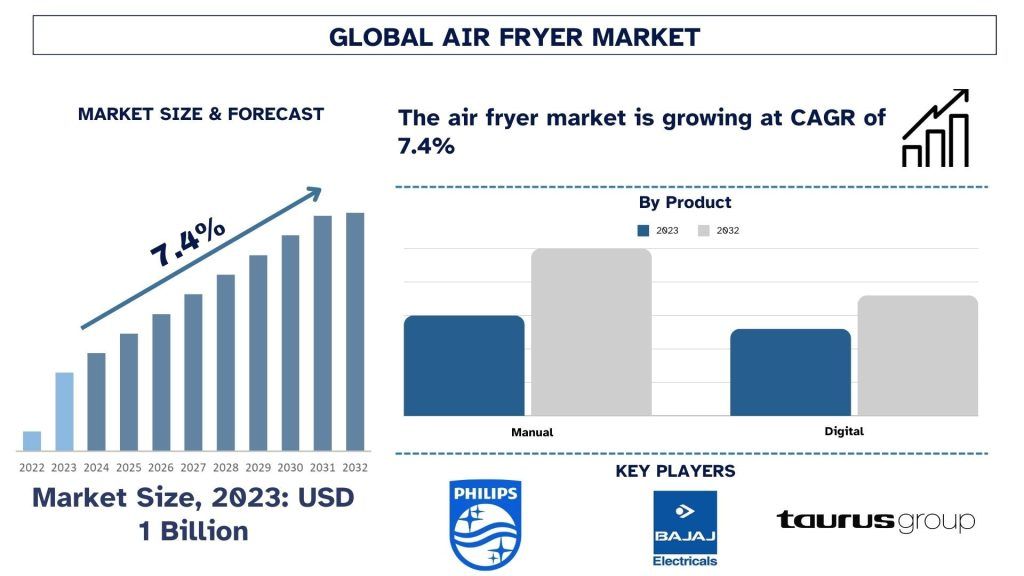- الرئيسية
- معلومات عنا
- صناعة
- الخدمات
- قراءة
- اتصل بنا
سوق القلايات الهوائية: التحليل الحالي والتوقعات (2024-2032)
التركيز على المنتج (يدوي، رقمي)؛ المستخدم النهائي (تجاري، سكني)؛ قناة التوزيع (عبر الإنترنت، خارج الإنترنت)؛ والمنطقة/البلد
حجم سوق القلايات الهوائية والتوقعات
بلغت قيمة سوق القلايات الهوائية حوالي 1 مليار دولار أمريكي في عام 2023 ومن المتوقع أن ينمو بمعدل نمو سنوي مركب قوي يبلغ حوالي 7.4٪ خلال الفترة المتوقعة (2024-2032) بسبب تزايد طلب المستهلكين على خيارات الطهي الصحية والراحة والتطورات التكنولوجية في أدوات المطبخ.
تحليل سوق القلايات الهوائية
القلايات الهوائية هي أجهزة مطبخ تستخدم الحمل الحراري لطهي الطعام عن طريق تدوير الهواء الساخن. وهي متوفرة في تنسيقات يدوية ورقمية. القلاية الهوائية اليدوية هي نوع من القلايات الهوائية التناظرية مع قرصين للوقت ودرجة الحرارة، بالإضافة إلى مصابيح مؤشر لإظهار متى يتم تشغيل الوحدة وتسخينها مسبقًا. القلاية الهوائية الرقمية هي نوع من القلايات الهوائية الأوتوماتيكية التي تحتوي على لوحة تحكم رقمية مع شاشة LCD ولوحة لمس. يسمح النموذج الرقمي للمستخدم ببرمجة المؤقتات دون الحاجة إلى إعادة ضبطها. يمكن أن يعزى الطلب المتزايد على القلايات الهوائية إلى تزايد الوعي الصحي والوعي باتباع نظام غذائي صحي عالميًا. بالإضافة إلى ذلك، فإن الطلب المتزايد على أجهزة الطهي منخفضة الزيوت يجعل من الضروري للاعب رئيسي تقديم ميزات وظيفية جديدة.
علاوة على ذلك، من المتوقع أن ينمو سوق القلايات الهوائية بسبب تزايد الوعي الصحي بين الشباب، إلى جانب تزايد الوعي بشأن الآثار السلبية لاستهلاك الأطعمة الزيتية. ومع ذلك، فإن بعض القيود في السوق، بما في ذلك ساعات الطهي الطويلة المطلوبة لطهي الطعام بشكل صحيح، والتي بسببها يتم استهلاك كمية كبيرة من الكهرباء، تعيق نمو هذا السوق في جميع أنحاء العالم.
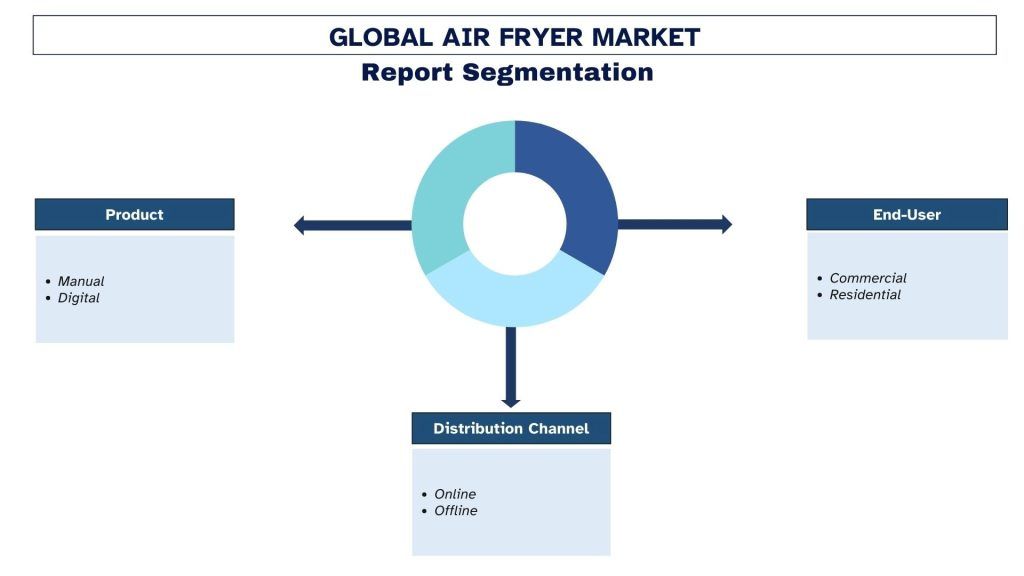
اتجاهات سوق القلايات الهوائية
يناقش هذا القسم اتجاهات السوق الرئيسية التي تؤثر على قطاعات القلايات الهوائية كما حددها خبراء الأبحاث لدينا.
القطاع الرقمي يحول الصناعة
استحوذ القطاع الرقمي على حصة سوقية كبيرة، ويقدر أنه سينمو بسرعة خلال الإطار الزمني المتوقع بسبب زيادة الطلب على أجهزة الطهي الأوتوماتيكية في البلدان المتقدمة. تم تجهيز القلايات الهوائية الرقمية بميزات جديدة مثل شاشات LCD وأجهزة استشعار درجة الحرارة وضوابط ترموستات مرنة وأوضاع طهي متعددة مثل max crisp، والقلي الهوائي، والتحميص الهوائي، والشوي الهوائي، والخبز، وإعادة التسخين، والتجفيف. تسهل هذه الميزات الراحة وتدفع الطلب.
أمريكا الشمالية هيمنت على السوق في عام 2023
الوعي الاستهلاكي العالي بالمطابخ الصحية وزيادة الطلب على حلول القلي منخفضة الزيوت هما العاملان الرئيسيان اللذان يدفعان نمو سوق القلايات الهوائية في أمريكا الشمالية. وبالتالي، يختار المستهلكون القلايات الهوائية لأن الجهاز يركز على جانب الصحة ويمكنه قلي الأطعمة بكمية أقل من الدهون. علاوة على ذلك، فإن الاتجاه المتزايد حيث تبنى معظم الناس في المناطق الحضرية أنماط حياة مزدحمة قد دفع أيضًا الطلب على أجهزة المطبخ المريحة سهلة الاستخدام. تشمل العوامل الأخرى الميزات التكنولوجية المحسنة كما تنعكس في شاشة اللمس الرقمية ووضع الطهي المحدد مسبقًا وزيادة قدرات الطهي من بين أمور أخرى. الأجهزة الذكية في المطبخ وخاصة الأجهزة الرائجة حاليًا وزيادة ASKIs في جميع أنحاء المنطقة تحفز نمو السوق.
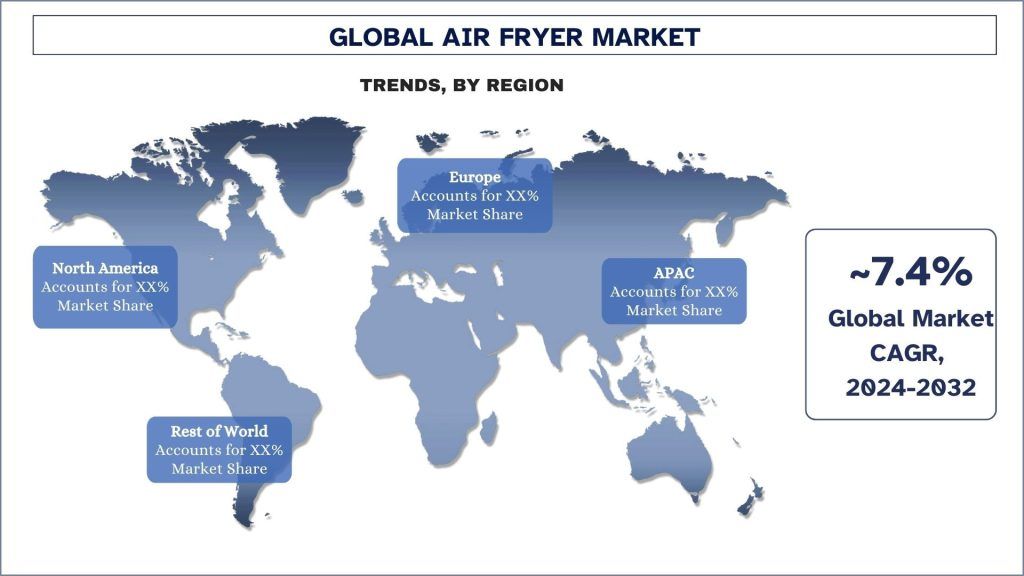
نظرة عامة على صناعة القلايات الهوائية
سوق القلايات الهوائية تنافسي، مع وجود العديد من اللاعبين في السوق العالميين والدوليين. يتبنى اللاعبون الرئيسيون استراتيجيات نمو مختلفة لتعزيز وجودهم في السوق، مثل الشراكات والاتفاقيات والتعاون وإطلاق المنتجات الجديدة والتوسعات الجغرافية وعمليات الاندماج والاستحواذ. بعض اللاعبين الرئيسيين العاملين في السوق هم Koninklijke Philips N.V و BLACK + DECKER و Breville Pty Ltd و GoWISE USA Services و SharkNinja Operating LLC و Bajaj Electricals Ltd و Domu Brands و Group Taurus و Newell Brands و De’ Longhi Appliances S.r.l.
أخبار سوق القلايات الهوائية
على سبيل المثال، في عام 2024، قدمت Xiaomi جهاز Xiaomi Air Fryer 6L، بعد عامين من إطلاق طراز 3.5 لتر في الهند. بالإضافة إلى السعة الأكبر، يحتوي الطراز الجديد أيضًا على لوحة تحكم تعمل باللمس جديدة تحتوي على 6 وصفات سريعة مُعدة مسبقًا، وخيار لضبط درجة الحرارة والمؤقت يدويًا مع الاحتفاظ بشاشة OLED.
تغطية تقرير سوق القلايات الهوائية
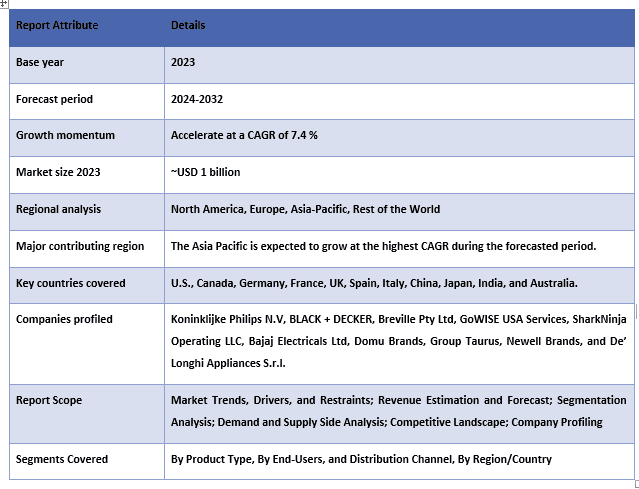
أسباب شراء هذا التقرير:
- تتضمن الدراسة تحليل لحجم السوق والتنبؤات تم التحقق من صحتها من قبل خبراء الصناعة الرئيسيين الموثوقين.
- يقدم التقرير مراجعة سريعة للأداء العام للصناعة في لمحة.
- يغطي التقرير تحليلاً متعمقًا لنظراء الصناعة البارزين مع التركيز الأساسي على البيانات المالية الرئيسية للأعمال ومحافظ المنتجات واستراتيجيات التوسع والتطورات الأخيرة.
- فحص تفصيلي للدوافع والقيود والاتجاهات الرئيسية والفرص السائدة في الصناعة.
- تغطي الدراسة السوق بشكل شامل عبر قطاعات مختلفة.
- تحليل متعمق على المستوى الإقليمي للصناعة.
خيارات التخصيص:
يمكن تخصيص سوق القلايات الهوائية العالمي بشكل أكبر وفقًا للمتطلبات أو أي شريحة سوقية أخرى. إلى جانب ذلك، تدرك UMI أن لديك احتياجات عملك الخاصة؛ لذا، لا تتردد في التواصل معنا للحصول على تقرير يناسب متطلباتك تمامًا.
جدول المحتويات
منهجية البحث لتحليل سوق القلايات الهوائية (2024-2032)
كان تحليل السوق التاريخي وتقدير السوق الحالي والتنبؤ بالسوق المستقبلي لسوق القلايات الهوائية العالمي هي الخطوات الرئيسية الثلاث التي تم اتخاذها لإنشاء وتحليل اعتماد القلايات الهوائية في المناطق الرئيسية على مستوى العالم. تم إجراء بحث ثانوي شامل لجمع أرقام السوق التاريخية وتقدير حجم السوق الحالي. ثانيًا، تم أخذ العديد من النتائج والافتراضات في الاعتبار للتحقق من صحة هذه الرؤى. علاوة على ذلك، تم إجراء مقابلات أولية شاملة أيضًا مع خبراء الصناعة عبر سلسلة القيمة لسوق القلايات الهوائية العالمي. بعد افتراض أرقام السوق والتحقق من صحتها من خلال المقابلات الأولية، استخدمنا نهجًا من أعلى إلى أسفل / من أسفل إلى أعلى للتنبؤ بحجم السوق الكامل. بعد ذلك، تم اعتماد طرق تقسيم السوق وتثليث البيانات لتقدير وتحليل حجم السوق للقطاعات والقطاعات الفرعية في الصناعة. يتم شرح المنهجية التفصيلية أدناه:
تحليل حجم السوق التاريخي
الخطوة 1: دراسة متعمقة للمصادر الثانوية:
تم إجراء دراسة ثانوية مفصلة للحصول على حجم السوق التاريخي لسوق القلايات الهوائية من خلال مصادر الشركة الداخلية مثل التقارير السنوية والبيانات المالية وعروض الأداء والنشرات الصحفية وما إلى ذلك، والمصادر الخارجية بما في ذلك المجلات والأخبار والمقالات والمنشورات الحكومية ومنشورات المنافسين وتقارير القطاعات وقاعدة بيانات الطرف الثالث والمنشورات الموثوقة الأخرى.
الخطوة 2: تجزئة السوق:
بعد الحصول على حجم السوق التاريخي للقلايات الهوائية، أجرينا تحليلًا ثانويًا مفصلاً لجمع رؤى السوق التاريخية وحصصها للقطاعات والقطاعات الفرعية المختلفة للمناطق الرئيسية. يتم تضمين القطاعات الرئيسية في التقرير، مثل التطبيق ووضع الدفع والمستخدم النهائي والمنطقة. تم إجراء المزيد من التحليلات على مستوى الدولة لتقييم الاعتماد الكلي لنماذج الاختبار في تلك المنطقة.
الخطوة 3: تحليل العوامل:
بعد الحصول على حجم السوق التاريخي للقطاعات والقطاعات الفرعية المختلفة، أجرينا تحليلًا تفصيليًا للعوامل لتقدير حجم السوق الحالي لسوق القلايات الهوائية. علاوة على ذلك، أجرينا تحليلًا للعوامل باستخدام متغيرات تابعة ومستقلة مثل التطبيق ووضع الدفع والمستخدم النهائي ومناطق القلايات الهوائية. تم إجراء تحليل شامل لسيناريوهات جانب الطلب والعرض مع الأخذ في الاعتبار أهم الشراكات وعمليات الاندماج والاستحواذ والتوسع التجاري وإطلاق المنتجات في قطاع سوق القلايات الهوائية في جميع أنحاء العالم.
تقدير حجم السوق الحالي والتنبؤ به
تقدير حجم السوق الحالي: بناءً على رؤى قابلة للتنفيذ من الخطوات الثلاث المذكورة أعلاه، توصلنا إلى حجم السوق الحالي واللاعبين الرئيسيين في سوق القلايات الهوائية العالمي والحصص السوقية للقطاعات. تم تحديد جميع تقسيمات الحصص المئوية المطلوبة وتقسيمات السوق باستخدام النهج الثانوي المذكور أعلاه وتم التحقق منها من خلال المقابلات الأولية.
التقدير والتنبؤ: لتقدير السوق والتنبؤ به، تم تخصيص أوزان لعوامل مختلفة بما في ذلك المحركات والاتجاهات والقيود والفرص المتاحة لأصحاب المصلحة. بعد تحليل هذه العوامل، تم تطبيق تقنيات التنبؤ ذات الصلة، أي النهج من أعلى إلى أسفل / من أسفل إلى أعلى، للوصول إلى توقعات السوق لعام 2032 للقطاعات والقطاعات الفرعية المختلفة عبر الأسواق الرئيسية على مستوى العالم. تتضمن منهجية البحث المعتمدة لتقدير حجم السوق ما يلي:
حجم سوق الصناعة، من حيث الإيرادات (بالدولار الأمريكي) ومعدل اعتماد القلايات الهوائية عبر الأسواق الرئيسية محليًا
جميع الحصص والتقسيمات والتقسيمات المئوية لقطاعات السوق والقطاعات الفرعية
اللاعبون الرئيسيون في القلايات الهوائية العالمية من حيث المنتجات المعروضة. أيضًا، استراتيجيات النمو التي اعتمدها هؤلاء اللاعبون للتنافس في السوق سريع النمو
التحقق من صحة حجم السوق وحصته
البحث الأولي: تم إجراء مقابلات متعمقة مع قادة الرأي الرئيسيين (KOLs)، بمن فيهم كبار المسؤولين التنفيذيين (CXO/VPs، رئيس قسم المبيعات، رئيس قسم التسويق، رئيس العمليات، الرئيس الإقليمي، الرئيس القطري، إلخ) في جميع المناطق الرئيسية. ثم تم تلخيص نتائج البحث الأولي وإجراء تحليل إحصائي لإثبات الفرضية المذكورة. تم دمج المدخلات من البحث الأولي مع النتائج الثانوية، وبالتالي تحويل المعلومات إلى رؤى قابلة للتنفيذ.
تقسيم المشاركين الأساسيين في مناطق مختلفة
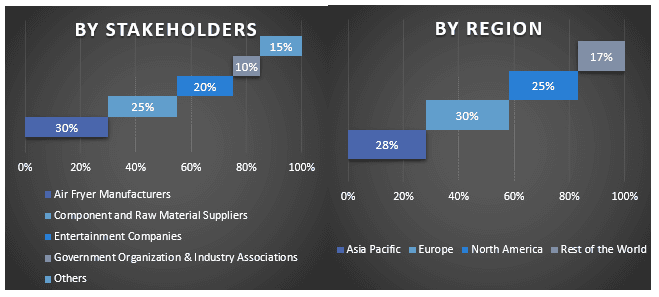
هندسة السوق
تم استخدام تقنية تثليث البيانات لإكمال تقدير السوق الإجمالي والوصول إلى أرقام إحصائية دقيقة لكل قطاع وقطاع فرعي من القلايات الهوائية العالمية. تم تقسيم البيانات إلى عدة قطاعات وقطاعات فرعية بعد دراسة معايير واتجاهات مختلفة في التطبيق ووضع الدفع والمستخدم النهائي ومناطق سوق القلايات الهوائية العالمي.
الهدف الرئيسي لدراسة سوق القلايات الهوائية العالمي
تم تحديد اتجاهات السوق الحالية والمستقبلية للقلايات الهوائية العالمية في الدراسة. يمكن للمستثمرين اكتساب رؤى استراتيجية لأساس تقديرهم للاستثمارات بناءً على التحليل النوعي والكمي الذي تم إجراؤه في الدراسة. حددت اتجاهات السوق الحالية والمستقبلية الجاذبية الإجمالية للسوق على المستوى الإقليمي، مما يوفر منصة للمشارك الصناعي لاستغلال السوق غير المستغلة للاستفادة من ميزة الريادة. تشمل الأهداف الكمية الأخرى للدراسات ما يلي:
- تحليل حجم السوق الحالي والمتوقع لسوق القلايات الهوائية من حيث القيمة (بالدولار الأمريكي). أيضًا، قم بتحليل حجم السوق الحالي والمتوقع للقطاعات والقطاعات الفرعية المختلفة.
- تشمل القطاعات في الدراسة مجالات التطبيق ووضع الدفع والمستخدم النهائي والمناطق.
- تحديد وتحليل الإطار التنظيمي للقلايات الهوائية
- تحليل سلسلة القيمة المعنية بوجود وسطاء مختلفين، إلى جانب تحليل سلوكيات العملاء والمنافسين في الصناعة.
- تحليل حجم السوق الحالي والمتوقع لسوق القلايات الهوائية للمناطق الرئيسية.
- تشمل الدول الرئيسية في المناطق التي تمت دراستها في التقرير آسيا والمحيط الهادئ وأوروبا وأمريكا الشمالية وبقية العالم
- ملفات تعريف الشركة لسوق القلايات الهوائية واستراتيجيات النمو التي اعتمدها اللاعبون في السوق للاستمرار في السوق سريع النمو.
- تحليل متعمق على المستوى الإقليمي للصناعة
الأسئلة الشائعة الأسئلة الشائعة
س1: ما هو الحجم الحالي لمقلاة الهواء العالمية وإمكانات نموها؟
س٢: ما هي العوامل الدافعة لنمو المقلاة الهوائية العالمية؟
س3: أي قطاع لديه الحصة الأكبر من المقلاة الهوائية العالمية حسب المنتج؟
س4: ما هي التقنيات والاتجاهات الناشئة في المقلاة الهوائية العالمية؟
س5: أي منطقة ستسيطر على المقلاة الهوائية العالمية؟
ذات صلة التقارير
العملاء الذين اشتروا هذا المنتج اشتروا أيضًا

